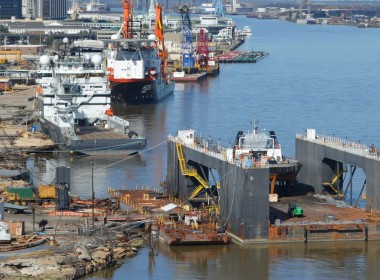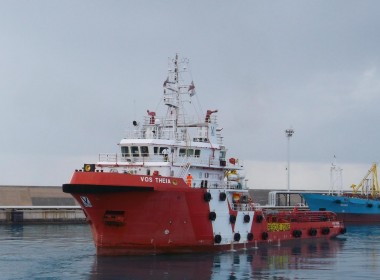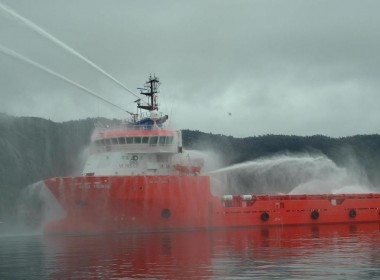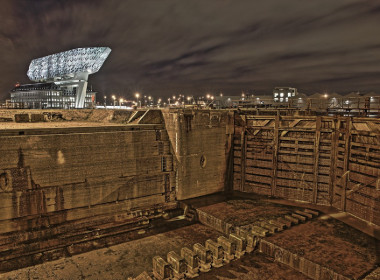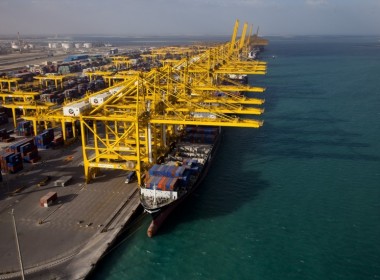REMINISCENCES | The best little shipyard in the world

Carrington Slipways, “the best little shipyard in the world”. A phrase that I heard often from shipowners right through to the yard workers themselves. A family-owned shipyard on the Hunter River near Newcastle that built dozens of tugs, fifty-five in fact. Having served my apprenticeship in a heavily unionised, strike ridden shipyard, it was refreshing to work in the relatively strike-free environment of Carrington Slipways.
The industrial harmony had a lot to do with the “family feel” of the workplace. Employees were proud of their work and they had a reputation that singled them out from other shipbuilders. From the early days of CAD lofting and shell plate cutting to the assembly line production of vessels, listening to clients and looking after the workforce, they just continued to improve. Trust, purpose and achievement were the unspoken values of the yard. They studied the best construction methods from Japan and ultimately the Japanese yards sent representatives to study Carrington’s methods.
These were the strengths of a little shipyard that started its life tucked into a corner of Newcastle harbour next to the Cowper Street bridge in Carrington. It was a shipyard that progressed from building barges and ferries, tugs and oilfield vessels to larger ships like HMAS Tobruk, the cement carrier Goliath and the Antarctic supply ship Aurora Australis right up to their last ship, Searoad Tamar.
It was a pleasure to work there. The man on the tools and in the drawing office, visiting surveyors or owners’ representatives were all treated with respect and valued for their presence.
“Ken Wikner drove the shipbuilding program and was the sea trials master that ‘got things done’.”
Carrington Slipways had a “can-do” reputation, which sometimes led to some unforgettable moments. One long-term employee and proud stalwart of Carringtons was Ken Wikner. A generous man, devoted to Carringtons’ with a heart as big as Pharlap.
Outside work Ken devoted his life to others. He was a scoutmaster, a member of the Lions club, the sole driving force behind the building of a replica of Australia’s first steamship, William the Fourth. He drove the shipbuilding program and he was the sea trials master that “got things done”. Nothing stood in his way. He was also the source of some hilarious moments, particularly during trials and commissioning times.
Launching days were always impressive. Side launches were the order of the day. One moment the ship was standing high and dry on the building berth and seconds later, after the launching lady had broken a champagne bottle on the bow, the ship was in the water. Typically, Carringtons bought expensive champagne for these events and typically expensive champagne comes in very thick glass bottles that didn’t always break at the first attempt. It would bounce back and almost take out the launching lady for her efforts.
More than one launching lady was reduced to tears until Kenny Wikner came to her rescue. He would jump the dais rail or go up in a cherry-picker with the launching lady’s daughter and smash the bottle against the hull until it broke.
A favourite trick on launching days was to suggest to new-comers that the best photographs could be taken if one is to stand at the after end of the ship. As it hit the water, a huge spray would jet from the Kort nozzles and drench the unsuspecting photographer. The wave generated by the side launch would rush across the launching basin and inundate the unsuspecting onlookers standing there for a better view. I went to about fourteen launches over the time I worked there but I take no responsibility for the hijinks that was played on the unsuspecting public.
The launching of Broadsword, a tug for Hay Point, caused a few breathtaking moments for all in attendance. She caught one of her propeller nozzles on the berth edge as she slid into the water. The tug rolled right over onto her side for several heart-stopping seconds before she righted herself. No real harm was done but the sight of a tug lying on its side is something to you don’t see every day.
“More than once we did, in fact, ‘miss the tide’ and spent the night on a mud bank halfway down the river, waiting for the next high tide.”
The modern Carrington Slipways moved up the Hunter River to a new bigger site at Tomago. It had man-made launching basins and outfit berths cut into the river bank. But the river, as always, was subject to tides.
There was always a frantic push to get as much outfit and commissioning work done at the yard before heading down river for sea trials. Invariably it was always touch-and-go with the tide and cries of, “You’ve left it too late, Wiko,” would usually be accompanied with the engines starting up and the tug pulling away from to berth with oxy hoses snapping and welding earth leads twanging. The shore gangway would be left hanging in the water.
More than once we did, in fact, “miss the tide,” and spent the night on a mud bank halfway down the river, chomping on deep fried chicken waiting for the next high tide.
But that wasn’t the end of the excitement. Once we made it downriver, we would conduct full power wharf trials at Newcastle’s Throsby wharf. For ASD tugs this involved turning both thruster units outboard (to a neutral position) and running at full power alongside the wharf for an extended time.
One day we noticed a Carrington Slipways truck quietly sinking through the wharf apron. The side-thrust of the tug had undermined the wharf and created a ute-sized hole in the wharf.
“Ken Wikner, by his force of character and never giving up, always delivered the vessel on time and on budget.”
Bollard pull tests were another the source of entertainment. Expediency over experience always caused something to go wrong (which was to be expected). The landside bollard was mounted on a rated 50-tonne concrete block.
When testing a 55-tonne bollard-pull tug, it was hoped that there was a good factor of safety on the bollard. But it wasn’t to be. If you can imagine a bollard, set in 64 cubic metres of concrete, pulling out of the ground, skipping across a roadway tearing up asphalt, watermains and power lines as the tug hit 55 tonnes, that was the outcome.
Bollard pull tests were always difficult when dredging operations put a halt to activities while the dredger passed up the channel near the bollard pull site. This break in proceedings once caused the tow wire to be caught around the curb log of the dolphin.
Not to be fazed, Wiko flagged down a passing mobile crane and offered the driver AU$20 to, “lift that wire over the curb”. He didn’t tell the driver there was a 500-tonne tug on the other end of the wire.
As soon as he lifted the wire, the crane started to topple over. The driver jumped free of the cab as the crane rolled across the wharf and into the harbour. Not to be concerned about this little setback, Ken whistled up another crane to lift the damaged crane out of the water. Surprisingly, the engine started and the driver returned the badly crushed crane to his depot (where I believe he was promptly sacked).
But the job got done. Ken Wikner, by his force of character and never giving up, always delivered the vessel on time and on budget.
“Wiko is no longer with us but the great memories of his larger-than-life personality live on.”
Sadly, in later years and after more than 150 successful newbuilds, Carrington Slipways fell to the vagaries of unfulfilled government promises, political indifference, and a liquidated damage claim due to late delivery of drawings from a third party. All these misfortunes happened at roughly the same time and the “best little shipyard in the world” finally closed its doors.
The site at Tomago is still there. It’s visible as you drive north over the Hunter River at Hexham. It’s been used by various other firms since those heady days of great shipbuilding, but they are just a memory now. Wiko is no longer with us but the great memories of his larger-than-life personality live on.
Submissions wanted! Do you have an exciting, amusing or downright dangerous anecdote from your time in the maritime world? Each week, we will feature new personal experiences from across the globe. Submissions to: [email protected].


